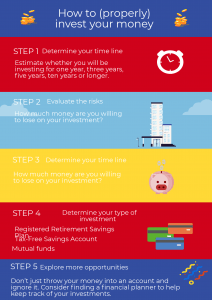By Sylvia Lorico
Whether you’re just looking to make money by investing, or hoping to make enough profit for a project or business, investing money is an asset that can help you grow wealth in Canada. But where should you put your money? How much are you hoping to make in the future? Here are some tips and breakdown of how to invest your money successfully.
1. Determine your time horizon
When you decide to invest your money, you need to figure out how long you plan to invest for. Plans can change but the important thing is to have a plan. Estimate whether you will be investing for one year, three years, five years, ten years or longer. A proper time horizon determines where to invest your money. Short-term investors typically put their money in easily accessible accounts like at major banks, while long-term investors will typically invest in the stock market or other areas where the potential for returns are high but are not always easy to sell.
2. Look at your risk tolerance
How much money are you willing to lose on your investment? Unless you’re burying your money in a hole and hoping it will grow, every investment has some associated risks. In the business world, risk is measured by credit ratings. The better the credit rating is, the less risky it is perceived to be. Governments usually have the best credit ratings followed by larger banks, smaller banks, companies and small businesses and individuals. Avoid investing money you can’t afford to lose and consider the worst-case scenario with every investment you make. The riskier the investment, the higher the odds that a worst-case scenario will occur. Also, if you start to invest when you’re younger, your rate of risk will be significantly lower because you have fewer assets.
3. Determine your expectations
You might say, “I want to earn a return of 50 per cent on my investment-every year.” However, this is unrealistic. People often lose money by chasing after impossible rates of return. Look into every investment carefully and consult with those you trust like your financial advisor or parents before making a decision. Keep in mind the positives and negatives in every investment. Remember: return is contingent on risk. If you invest in high-risk stocks, your return might be high but it’s at the risk of losing a significant amount of funds. If you invest in low-risk accounts, on the other hand, expect that your returns will be lower but your funds will likely remain stable.

Infographic by Alanna Rizza and Karoun Chahinian
4. Determine the type of investment
Unfortunately, money doesn’t grow on trees. However, there are several options to invest your money instead of planting it into the ground. Here are a few options broken down:
Mutual funds:
At its core, a mutual fund is a managed portfolio of stocks and/or bonds. A manager selects companies that will be in their fund. Thus your money is invested in hundreds of companies sometimes residing in the same sector or geographical market. This is a good way to avoid investing in just one area to minimize your risk when building an investment portfolio.
Registered Retirement Savings Plan (RRSP):
The purpose of an RRSP is to build savings for retirement by reducing the amount of income taxes you’re required to pay. You can contribute up to 18 per cent of the income you earn in a year. These contributions are deducted from your income for tax purposes, but the investment income is taxable when withdrawn. Another handy tip is that you can withdraw funds from your RRSP to finance your education or withdraw up to $25,000 tax-free to buy or build your home.
Tax-Free Savings Account (TFSA):
This account allows you to save your revenue from taxes regardless of your annual income. Each year, you can make contributions to your TFSA within an annual limit established by the Government of Canada which carry over each year. The income earned in your TFSA is not taxable even when withdrawn from your account. However, it does not provide any tax benefits.
5. Explore more opportunities
So you’ve finally put some money away to grow. Congratulations! You’re well on your way to being richer in the future and a bona fide adult. That being said, don’t just throw your money into an account and ignore it. Consider finding a financial planner to help plan and keep track of your investments. Most of all, keep looking into ways to invest. More than one investment reduces your risk and increases your return!










Leave a Reply